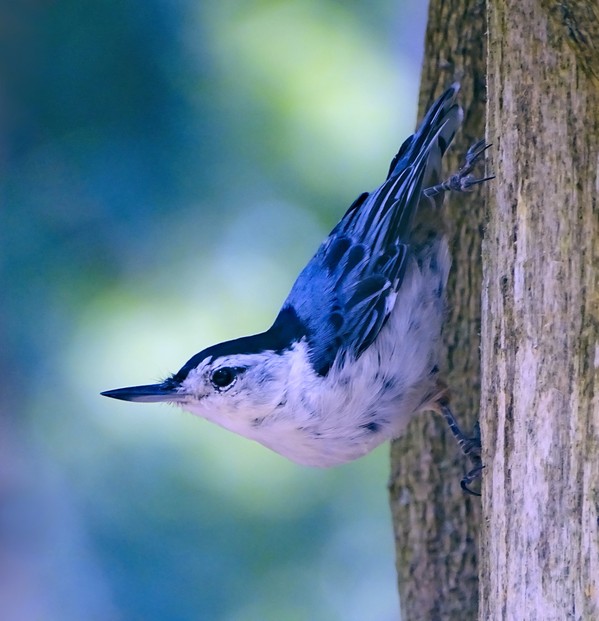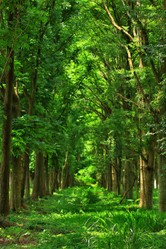There is a deep pleasure in planting a tree, tinged by the knowledge that you are planting for future generations, for should it live to its natural span, the tree will last longer than you will. Occasionally, I still see the tree that I was selected to plant in a local park when I was ten years old and get a feeling of pride knowing that it is still there over half a century later, now transformed from a fragile sapling into a sturdy birch. I don't see it often, but it is still there in my mind, the first among several that I have put into the good Earth. But any planting of a woodland is an act of generosity from the present to the future, and this is what is to happen in the North of England over the next twenty five years.
England's north consists of five counties, in the North West two and North East three, the two groups being divided by the long Pennine Hills that stretch from the midlands to the Scottish borders. As you can see from the map the towns at the opposite sides are Liverpool and Hull, and between them there is an area marked in green, which indicates a national park, the scenic Peak District, Britain's first national park. The new Northern Forest will stretch from Liverpool in the West to Hull in the East and going north-eastwards along the M62 corridor towards Leeds.
But be aware that the term forest is a bit flexible. When the Americans speak of forest they refer to the massive woodlands of North America. Well, ours are inevitably smaller than this. Furthermore, forest is a technical term in English law that did not originally denote only a woodland, but a stretch of land, sometimes moorland, reserved for royal hunting, which provided the king's court with venison and wild boar meat. The royal hunting bit has ended now. So the new Northern Forest will not consist of unbroken, extended woodland coverage, but of a network of interlinked woods from one side of the country to the other. As Northern England is the narrowest region of the country, you can do this, while it would be far more difficult in the far larger southern parts of the island.
Northern England needs trees. It is an industrial landscape of large conurbations, small towns and mining villages, which acquired its present structure at the industrial revolution. There are wasted, now derelict industrial lands and abandoned coal mines in places. In the middle is the often bleak Pennine Range, whose centre is the dry, bare limestone sheep farming landscape, with rims of millstone grit, the landscape of the Bronte sisters. Some of the summits are covered with thick boglands, places that are of national importance as I will show further on. This is not to say that there is no natural beauty, for there is much of it, including stretches of farmland, but the beauty is often wild, empty moorland and it is considered that there are not enough woodlands, especially outside the national park.








 TheThousand Year Gardenon 11/26/2025
TheThousand Year Gardenon 11/26/2025
 Women of the Gospelson 10/11/2025
Women of the Gospelson 10/11/2025
 Religious Gardenson 08/25/2025
Religious Gardenson 08/25/2025
 Doctor of the Church: John Henry Newmanon 08/03/2025
Doctor of the Church: John Henry Newmanon 08/03/2025



Comments
An estate owner thought that they would be a nice addition to the fauna of his estate, and he did not consider the ecological impact.
Thank you for your comment below, in answer to my previous observation and question.
Your comment three boxes down, on Feb. 26, 2020, in answer to my previous, same-day observation and question advises us that "grey squirrel was deliberately imported into Britain without any consideration of its ecological impact."
Why might they have been imported when the red squirrels already were there on the east pond side?
Yes. Red squirrels eat the nuts as well.
Thank you for your comment below, on Feb. 26, 2020, in answer to my previous, same-day observation and question.
Squirrels and their hazelnuts intrigue me.
The countryside here lacks any hazelnut trees nearby. So gray squirrels like black walnuts and Chinese/hybrid chestnuts in the south yard.
Might red squirrels munch on chestnuts and walnuts in the British Isles?
Derdriu,the grey squirrel was deliberately imported into Britain without any consideration of its ecological impact. But red squirrels were not exported, as far as I know.
I think that red squirrels eat hazelnuts, but as, unlike grey squirrels, they cope with conifers, they can also eat pine nuts, so they did not pose such a demand on hazelnut supplies.
frankbeswick, Thank you for the photo, practicalities and products (particularly the quirky chest of drawers).
Did people deliberately import grey squirrels into, and export red squirrels from, England? It's my understanding that the former lived in the proto-United States and the latter across the pond and that during European settlement they switched ranges. Was the red squirrel not interested in hazel tree edibles?
Thanks for the explanation about the willow. I do hope you are still around in your nineties and spry enough to enjoy seeing this forest in person. Even so, it's nice to realize it will be there to enjoy with or without you around.
I am glad to read a comment from you, Dustytoes, as I always enjoy what you say.
Willow soaks up water, especially when it is at its greatest growth rate [when young] so to keep up its absorption capacity it is a good idea to harvest willow at some stage for biomass and let strong young shoots grow again. The best to do this is the ancient technique of coppicing, which creates coppiced vigour in a tree. We are having flooding problems in the North of England, so I am keen to take measures that soak up some flood water.
You have read my article insightfully, for I imagined that the couple might be my relatives. I chose 2042 because it is twenty five years hence when the forest will have reached maturity. I would like to see it, but by then I would be ninety two, possibly still around, but unlikely.
This sounds like an excellent plan. When planting trees one must be thinking of the future where both people and animals can enjoy these life-giving plantings. I have a question about your remark about the willow that "will need harvesting"... and what you mean by that?
You are obviously picturing in your mind a day far in the future when your grandchildren and great-grandchildren can enjoy this forest. I loved reading about it.
We are unlikely to grow much field maple as in Britain it tends to prefer the chalky soils of the South East, and its relative Sycamore is non-native. We have enough fir, spruce and pine, so they will not be planted.
Hazel is a tree valued for its nuts that once the British working classes used to collect in woodlands, until the grey squirrel, which was imported from North America, ate them. We could plant hazel if planting goes with strategies to manage the grey squirrel, though recently it has been learned that the most effective anti-grey squirrel strategy is to re-introduce the predatory pine marten, which [with the exception of stolen picknickers' jam sandwiches] likes nothing more than lunching on grey squirrel.
You are right about soil erosion on hill tops.I know of no hill top trees, for not only is the soil shallow, the winds in Winter can be brutal